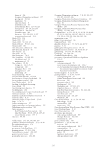Lake Eyre Basin Rivers 110 Many people living in the Lake Eyre Basin have family or friends from the Murray–Darling Basin and so there is a good appreciation of its significant environmental problems, straining from over use. Far too much water was extracted from the Murray–Darling Basin. The problems started small and increased (see Chapter 15). A few people wanted to extract ‘a little bit of water’, often complaining that it was going to waste when it went past them. This was the history of the Murray–Darling Basin and the overdevelopment of its rivers. We have to do much better for the sustainability of the rivers of the Lake Eyre Basin. We live on the world’s driest inhabited continent, and water is scarce and critical. We need to be smart. Life out here in the arid zone of Australia is predicted to become even more difficult with climate change impacting Lake Eyre Basin rivers. The signs are clear as temperatures rise (Reisinger et al. 2014). Increasingly longer periods of high temperatures, above critical thresholds, are particularly concerning. Temperatures in March 2015 may be a portent of a grim future. We experienced one of the hotter autumn periods ever recorded, with temperatures exceeding 40°C for 20 consecutive days. Extreme heat waves during summer have killed birds, kangaroos and occasionally domestic pets in outback Australia. The projections are for increasingly intense rainfalls, separated by long, dry periods (Greenville et al. 2012). This inevitably means either extremely high flows or long periods of low flows or no flow in the rivers. This has major implications for the last remaining waterholes in the Channel Country and in South Australia, which act as refuges (Hamilton et al. 2005). These habitats provide oases in a desert landscape for aquatic animals and also terrestrial animals. It is critical that we allow all floods to run unimpeded. Low flows can be particularly critical during the long dry periods (Bunn et al. 2006). For those of us who depend on the water of the rivers, it is going to be harder and drier, with potentially more intense floods but long, dry periods in between. We have a collective responsibility for the sustainability of the Lake Eyre Basin. The management of the Basin has required a joint, cooperative approach between the states of South Australia, Queensland, the Northern Territory and the Australian Government. This is achieved through the Lake Eyre Basin Intergovernmental Agreement (see Chapter 7). It aims for cooperative management, focusing on maintaining naturally variable flow regimes and water quality which fundamentally underpin the health of these systems. It takes a precautionary approach to management. Over the past 20 years, we have had thousands of people involved in hundreds of meetings to give effect to this agreement. Community, industry and science have worked together to chart a sustainable path to the future (see Chapter 7). Once again, there are multiple threats to this agreed future along the Lake Eyre Basin rivers, particularly from mining and irrigation (see Chapters 19 and 20). Many people believe that the Lake Eyre Basin is not suitable for these developments. Most people involved in advising governments about the Lake Eyre Basin over the last 20 years are committed to ensuring the rivers are not regulated or large amounts of water diverted. As with the Murray– Darling Basin rivers, talk is about a little bit of development (see Chapter 22), but history can have an unhappy habit of repeating itself.
Downloaded from CSIRO with access from at 216.73.216.88 on Nov 13, 2025, 2:31 AM. (c) CSIRO Publishing

















































































































































































































































































